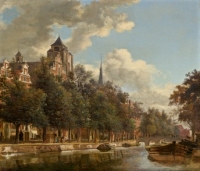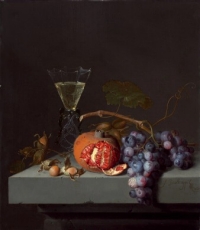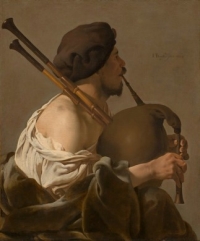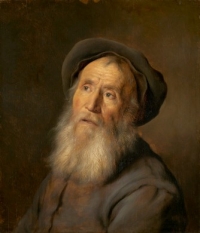Depictions of city and countryside were integral to 17th-century Dutch art. Painters rendered the seemingly-plain topography of the Netherlands with extraordinary sensitivity to the subtleties of light and atmosphere. The flat countryside also made city skylines into iconic features, and some artists specialized in views of these flourishing urban centers. Vignettes of daily life appear in landscapes both large and small, reflecting a burgeoning sense of national pride. For example, paintings often celebrate the fruits of the Dutch countryside by depicting farmers and herdsmen at work. The sea, which promised both profit and peril, was also a compelling subject. Exceptionally accurate renderings of ships are common in Dutch seascapes, which ranged from tranquil harbor views to turbulent shipwrecks. Dutch artists visiting Rome painted views of the Italian countryside, reminding us that Dutch viewers were enchanted by foreign vistas as well.
Landscapes
See all Dutch landscapes
Jan van der Heyden
View Down a Dutch Canal, c. 1670
Gift of George M. and Linda H. Kaufman 2012.73.2
Still Lifes
See all Dutch still lifes
Jacob van Walscapelle
Still Life with Fruit, 1675
Juliet and Lee Folger/The Folger Fund
2001.71.1
17th-century Dutch still lifes offer remarkably vivid illusions of reality. Viewers delighted in artists’ consummate skill in capturing the effects of light on a wide range of materials and textures, sometimes creating artworks that tricked viewers, if only momentarily, into mistaking the paintings for real objects. Artists painted tabletop scenes of bread and cheese; sumptuous banquets; hunting pieces with dead game; floral bouquets, sometimes combined with images of fruits and shells; and scholars’ desks cluttered with books and papers. The vast reach of the Dutch commercial empire can be seen in the imported Chinese porcelain, lemons and spices, and exotic flora and fauna that appear in many of these works. Amidst this luxury, however, artists often included extinguished candles, skulls, and wilting leaves to serve as warnings about the transience of worldly pleasures.
History Paintings
See all Dutch history paintings
Hendrick Goltzius
The Fall of Man, 1605
Patrons' Permanent Fund
1996.34.1
History paintings depict not only contemporary events but also literary subjects, including Greek and Roman mythologies and stories from the Bible. Although the political and religious turmoil of the Eighty Years’ War (1589–1648) profoundly affected 17th-century Dutch society, direct illustrations of land and sea battles are relatively rare compared to the wealth of biblical paintings from the period. Unlike the grand public altarpieces made for Catholic churches by Flemish artists, most Dutch religious paintings, like Rembrandt’s emotionally evocative renditions of New and Old Testament stories, were meant for private display and contemplation.
Genre Paintings
See all Dutch genre paintings
Hendrick ter Brugghen
Bagpipe Player, 1624
Paul Mellon Fund and Greg and Candy Fazakerley Fund
2009.24.1
While 17th-century Dutch sources used descriptive terms like “merry companies” and “picnics” when referring to scenes of daily life, today we call them “genre paintings.” Artists represented all levels of Dutch society, from rustic beggars and musicians to middle-class citizens and wealthy patricians. Some genre paintings are decidedly humorous and satirical, while others offer a more sympathetic view of their subjects. Whether comical or dignified, these paintings reveal much about the social activities and values of the time: a Dutch woman busy with household chores, peasants enjoying an evening at a local tavern, or a suitor’s call on an eligible young lady. Although these paintings seem to present unmediated representations of daily life, painters sometimes included objects with symbolic associations that lent their scenes a moralizing character.
Portraits
See all Dutch portraits
Jan Lievens
Bearded Man with a Beret, c. 1630
Gift of George M. and Linda H. Kaufman
2006.172.1
The flourishing Dutch economy in the 17th century greatly expanded the market for portraiture. Skilled portrait painters received commissions from newly wealthy merchants and their wives, members of civic guards, and religious leaders. Early in this period, many portraits conformed to longstanding conventions, using formal, impersonal poses to convey the sitter’s distinguished status. However, innovative painters like Rembrandt and Frans Hals soon began to expand these conventions by infusing both individual and group portraits with increased naturalism and vivacity that signaled their subjects’ intellectual and social acumen. Informal character studies, or tronies, were also in great demand, as were artists’ portraits and self-portraits, as Dutch painters laid claim to their growing reputation both at home and abroad.
